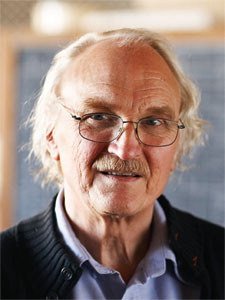From wood waste to diesel fuel

An IREE grant recipient and international partners aim to develop carbon-neutral diesel fuel from Minnesota paper mills.
David Kittelson’s latest project—to develop an efficient, clean, potentially carbon-neutral substitute for diesel fuel known as DME—hasn’t won support from the federal government.
But that hasn’t deterred the University of Minnesota College of Science and Engineering professor. He has found partners elsewhere, including GM, Volvo (one of the world’s largest manufacturers of truck engines), Chemrec (a Swedish biorefining company), and the Institute on the Environment’s Initiative for Renewable Energy and the Environment. “They’re betting on DME as a future diesel fuel,” says Kittelson.
Already the project has launched several patent applications on new-generation fuel systems.
Says Kittelson, “This IREE grant has probably produced more intellectual property than any of the other IREE grants.”
Kittelson likes the prospects for DME, short for dimethyl ether. Though usually refined from fossil fuels, DME can also be produced from biological sources. As such, it is more efficient than nearly all other biofuels. Corn-based ethanol, for example, requires nearly as much energy to produce as it yields as a fuel. DME, says Kittelson, produces about 10 times the energy it takes to make.
DME has other advantages as well. It’s a known commodity with properties nearly identical to propane, which is already used in vehicle engines. DME has high power output in a modified diesel engine, while burning with no soot and producing very little pollution of any kind. That solves one of diesel’s bugaboos—emission of hazardous fine particles that must be captured with expensive exhaust filters.
Kittelson’s lab is examining the economics and life-cycle greenhouse gas emissions of producing DME from a wood waste known as black liquor at a northern Minnesota pulp plant, then using the fuel as a substitute for conventional diesel. Such production is already underway in Sweden. DME from Minnesota mills could meet up to 10 percent of the state’s diesel fuel needs, Kittelson estimates.
Kittelson and colleagues are also trying to produce a better DME engine from state-of-the-art diesel engines donated by GM. One of Kittelson’s students spent a career in the automotive industry before coming out of retirement to pursue a degree in mechanical engineering. He is leading work on a new generation of fuel injection to work with either propane or DME. Says Kittelson, “We’ve got this fantastic combination here of somebody who can develop both fuel systems.”
Like other novel fuels, DME faces a chicken-and-egg conundrum. Without thousands of DME vehicles on the road, no one will produce the fuel. And if the fuel isn’t available, no one will produce the vehicles. “One way around that is finding other uses for DME,” says Kittelson. One such use is home heating in rural areas. “It turns out DME is an excellent replacement for propane, sort of biopropane.”
The U.S. Department of Energy hasn’t been keen on DME because it can’t “drop in” as a direct substitute for conventional fuels. In the absence of federal support, Kittelson says, IREE funding has been invaluable.
“IREE has given us a chance to really look at things that are long-term, relatively high-risk projects,” he says. “I think they have really been indispensable in terms of looking at things that don’t fit into a niche of what the federal government has identified as directions they want to fund.”
